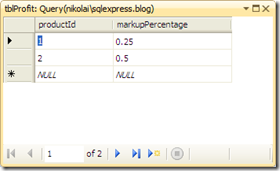calling a stored proc from another stored proc and getting results
I am not a SQL DBA but like a lot of developers I do get to work in relational databases. Also I guess like a lot of developers I find SQL to be the most alien of the languages I work in.
Recently I needed to refactor some code that had an impact on a database, in common with the DRY techniques I wanted to remove duplicated calculations. I’ve simplified this example to make it easier to read.
Data needs to be returned from a SQL Server database to the web site DAL, the code in the DAL used ExecuteScalar to get results back from the stored procedure. We need to calculate the profit for a given product and net price combination as well as being able to calculate the total cost
The profit for each product is held on a table like this
The calculation for the profit is performed by a procedure like this
ALTER PROCEDURE dbo.prGetProfit ( @productId int, @netPrice real ) AS declare @markupPercentage as real, @profit as real set @markupPercentage = (select markupPercentage from tblProfit where productId = @productId) set @profit = @netPrice * @markupPercentage select @profit as profitAC return @profit
When run in Visual Studio it looks like this
Running [dbo].[prGetProfit] ( @productId = 1, @netPrice = 100 ). profit 25 No rows affected. (1 row(s) returned) @RETURN_VALUE = 25 Finished running [dbo].[prGetProfit].
All is good, to implement the total cost we could implement the profit logic again and add back on the net price however we want to eliminate the duplicated logic. At first glance this looks easy we could write a procedure like this
ALTER PROCEDURE dbo.prGetTotalPriceFirstAttempt ( @productId int, @netPrice real ) AS declare @totalcost as real, @profit as real exec @profit = prGetProfit @productId = @productId, @netPrice = @netPrice set @totalcost = @netPrice + @profit select @netPrice + @profit as totalCost
and run it like this
Running [dbo].[prGetTotalPriceFirstAttempt] ( @productId = 1, @netPrice = 100 ). profit 25 No rows affected. (1 row(s) returned) totalCost 125 No rows affected. (1 row(s) returned) @RETURN_VALUE = 0 Finished running [dbo].[prGetTotalPriceFirstAttempt].
However if you look carefully in the output from calling the procedure the first returned value is the profit, then the total cost is returned and its the first value that gets returned into the DAL.
What we need to do is rewrite the EXEC line to call the prGetProfit stored procedure so that the profit value is calculated and returned correctly, without outputting it. We still need direct calls to prGetProfit to work so we cannot change that stored procedure.
It turns out to be a bit more complex that it looks at first however the following procedure
ALTER PROCEDURE dbo.prGetTotalPrice ( @productId int, @netPrice real ) AS declare @totalcost as real, @profit as real declare @Result TABLE (profit real) insert into @Result exec prGetProfit @productId = @productId, @netPrice = @netPrice select @profit = profit from @result set @totalcost = @netPrice + @profit select @totalcost as totalCost
when called produces the correct result
Running [dbo].[prGetTotalPrice] ( @productId = 1, @netPrice = 100 ). totalCost 125 (1 row(s) affected) (1 row(s) returned) @RETURN_VALUE = 0 Finished running [dbo].[prGetTotalPrice].
Note that only the total price is returned.
